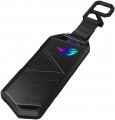Drive interface
Drive interface provided in the design of the pocket, in other words, a way to connect the drive.
It makes sense to use pockets for internal drives, so the appropriate interfaces are used for connection. Also note that in internal models (see "Type") the interface of the drive is often not specified, since it corresponds to the interface for connecting the pocket itself to the computer. As for specific options, here are the most relevant for today:
— SATA 3. The newest and most advanced, and in storage pockets, the most common version of the SATA interface. This interface is designed for internal storage, primarily hard drives; for SSD, it is relatively poorly suited, since it does not allow realizing all the potential of solid-state memory. Specifically, SATA 3 provides data transfer rates up to 600 MB / s, while earlier SATA drives can also be connected to such connectors — unless the connection speed is limited by the capabilities of a slower interface.
It is worth saying that in addition to traditional 2.5" and 3.5" SATA drives (see "Form factor") connected via the connector of the same name, nowadays you can also find M.2 form factor SSD modules that also use a SATA format connection . Such models are noticeably inferior in speed to solutions for M.2 PCI-E, but they are also cheaper. They are connected to the M.2 socket, which must support SATA.
— SATA 2. The predecessor of the SATA 3 described above; this version allows you to t...ransfer data at speeds up to 300 Mbps. In pockets, it is much less common, mainly among outdated models — for example, external solutions using USB 2.0 (see "Connection").
— PCI-E. A variant found exclusively on M.2 drive models (see Drive Form Factor). Such modules use the M.2 connector, the connection through which is most often implemented in the PCI-E format. At the same time, the specifications, usually, specify the version and number of PCI-E lines — the supported speeds directly depend on this. For example, the marking "PCI-E 3.0 2x" means 2 lines of PCI-E version 3.0; this version provides 984 Mbps per lane, so the overall speed is about 1.97 GB/s. However, nowadays, more advanced options are more common — for example, PCI-E 3.0 4x, where the speed is already about 3.9 Gbps. At the same time, drives and pockets with different versions and the number of PCI-E lanes in this case are usually compatible with each other, except that the speed will be limited by the capabilities of a slower interface.
— SATA/SAS. Models that support connection via two interfaces — SATA or SAS. The latter is a specialized standard used primarily in server systems; pockets with this feature also have a corresponding purpose. And this versatility is achieved due to the fact that SAS controllers are also compatible with SATA drives, so you can provide both types of connectors in your pocket. At the same time, SAS noticeably outperforms SATA in terms of operating speed — it is up to 22.5 Gbps, depending on the version (against a maximum of 6 Gbps in SATA). However, note that the SAS interface does not have a strictly defined type of connector — several types of plugs can be used for such a connection; this point needs to be specified separately.
Max. drive size
The maximum storage capacity supported by the pocket. In models with multiple disks/SSDs (see "Drive Slots"), this item indicates the largest total volume supported by the device; by dividing this capacity by the number of slots, you can determine the maximum allowable capacity of each individual drive.
The limitation on the maximum volume is relevant mainly for external models, including docking stations (see "Type"). This is due to the fact that fundamentally different interfaces are used for the drive and for connecting the pocket itself in such models (most often SATA and USB, respectively, see above for details). For the normal interaction of such interfaces, an electronic controller is required; and the larger the volume of the installed drive (s) — the higher the requirements for the performance of such a controller.
Note that, other things being equal, supporting large volumes is more expensive, and capacious drives themselves are not cheap. Therefore, when choosing according to this indicator, it is worth considering real needs, and not chasing the maximum numbers.

